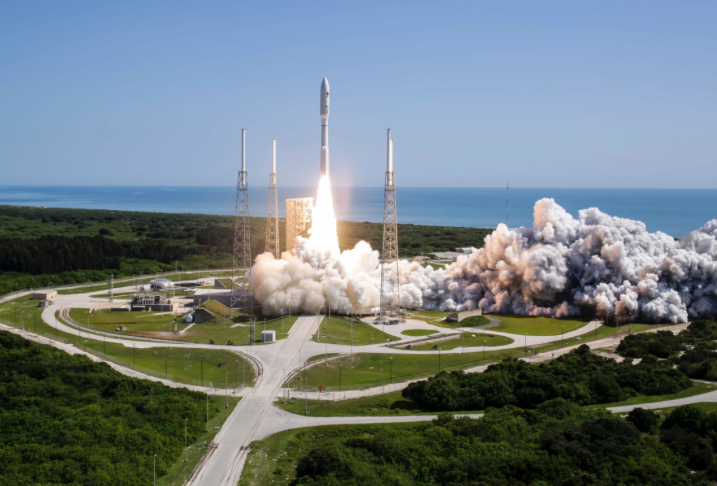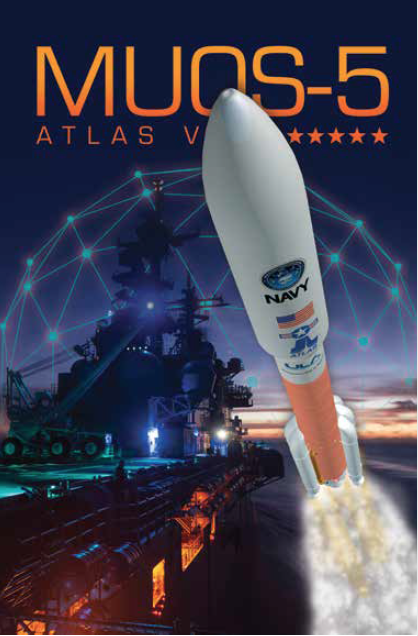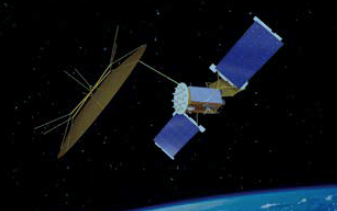
Cape Canaveral Air Force Station, Florida. (June 24, 2016) – A United Launch Alliance (ULA) Atlas V rocket carrying the MUOS-5 mission lifts off from Space Launch Complex-41 at 10:30 a.m. EDT.
Photo by United Launch Alliance
Cape Canaveral Air Force Station, Florida, (June 24, 2016) – A United Launch Alliance (ULA) Atlas V rocket successfully launched the MUOS-5 satellite for the U.S. Navy. The rocket lifted off from Space Launch Complex-41 June 24 at 10:30 a.m. EDT.
MUOS-5 is the final satellite in the five-satellite constellation, which provides warfighters with significantly improved and assured communications worldwide.
“We are honored to deliver the final satellite in the MUOS constellation for the US Navy,” said Laura Maginnis, ULA vice president, Custom Services. “Congratulations to our navy, air force and Lockheed Martin mission partners on yet another successful launch that provides our warfighters with enhanced communications capabilities to safely and effectively conduct their missions around the globe.”

The mission was ULA’s fifth launch in 2016 and 108th launch since the company formed in 2006. MUOS-5 was the seventh mission to be launched aboard an Atlas V Evolved Expendable Launch Vehicle (EELV) 551 configuration vehicle, which includes a 5-meter diameter payload fairing and five solid rocket boosters. The Atlas booster for this mission was powered by the RD AMROSS RD-180 engine and the Centaur upper stage was powered by the Aerojet Rocketdyne RL10C-1 engine.
“I am so proud of the team for all their hard work and commitment to 100 percent mission success,” Maginnis said. “It is amazing to deliver our second national security payload from the Cape in just two weeks. I know this success is due to our amazing people who make the remarkable look routine.”
ULA's next launch is the Atlas V NROL-61 mission for the National Reconnaissance Office, scheduled for July 28 from Space Launch Complex-41 at Cape Canaveral Air Force Station, Florida.
The EELV program was established by the U.S. Air Force to provide assured access to space for Department of Defense and other government payloads. The commercially developed EELV program supports the full range of government mission requirements, while delivering on schedule and providing significant cost savings over the heritage launch systems.
With more than a century of combined heritage, United Launch Alliance is the nation’s most experienced and reliable launch service provider. ULA has successfully delivered more than 100 satellites to orbit that provide critical capabilities for troops in the field, aid meteorologists in tracking severe weather, enable personal device-based GPS navigation and unlock the mysteries of our solar system.
End ULA Statement
Atlas V Muos-5 Mission
The U.S. Navy’s fifth Mobile User Objective System (MUOS-5) satellite completes the initial configuration of an advanced network of orbiting satellites and relay ground stations that is revolutionizing secure, tactical UHF communications for mobile military forces. Users with MUOS terminals can seamlessly connect around the globe with new smart phone-like capabilities, including simultaneous crystal-clear voice, video and mission data on a high-speed Internet Protocol-based system.

Image courtesy of Lockheed Martin Corporation
Delivering the next generation of narrowband communications, each MUOS satellite has two payloads supporting both new, advanced Wideband Code Division Multiple Access (WCDMA) waveform capabilities and the legacy UHF satellite system. Once fully operational, MUOS will provide users with 10 times more communications capacity than the legacy system.
Once on-orbit, the MUOS-5 satellite, with its 14-meter diameter reflecting mesh antenna, will augment the constellation as an on-orbit spare for the WCDMA capabilities while actively supporting the legacy system. The current MUOS network of four satellites and associated ground stations provides near global coverage. Lockheed Martin is the MUOS prime contractor and system integrator.
Some new MUOS features include:
- MUOS network users will be able to talk direct to, text, and transfer mission data amongst any other beyond line-of-sight MUOS users around the world. Legacy systems users can only communicate with each other by voice as long as they were under the coverage footprint of the same satellite.
- The MUOS WCDMA advanced waveform allows improved connectivity in stressed environments, including naturally scintillated, double canopy forested, mountainous and multi-path urban environments.
- Once MUOS is declared operational, the number of MUOS users is expected to grow rapidly. Already, more than 55,000 currently fielded radio terminals can be upgraded to be MUOS-compatible, with many of them requiring just a software upgrade.
The Most Powerful Rocket In The Atlas V Fleet—ATLAS V 551
Producing more than two and a half million pounds of thrust at liftoff, the Atlas V 551 rocket is the most powerful in the Atlas V fleet. In its 10 years of service, the 551 rocket has launched groundbreaking missions for our nation—from the critically important MUOS constellation to historic science missions including New Horizons, the first mission to Pluto and the Juno mission to Jupiter. MUOS is changing the way we support our troops in the field while New Horizons returned the first images of Pluto in 2015 and later this summer Juno will begin its quest to understand the origin of Jupiter.
First Launch: Jan. 19, 2006 Launches to date: 6
Performance to GTO: 8,900 kg (19,620 lb) Performance to LEO-Reference: 18,850 kg (41,570 lb) [page1image18056]

